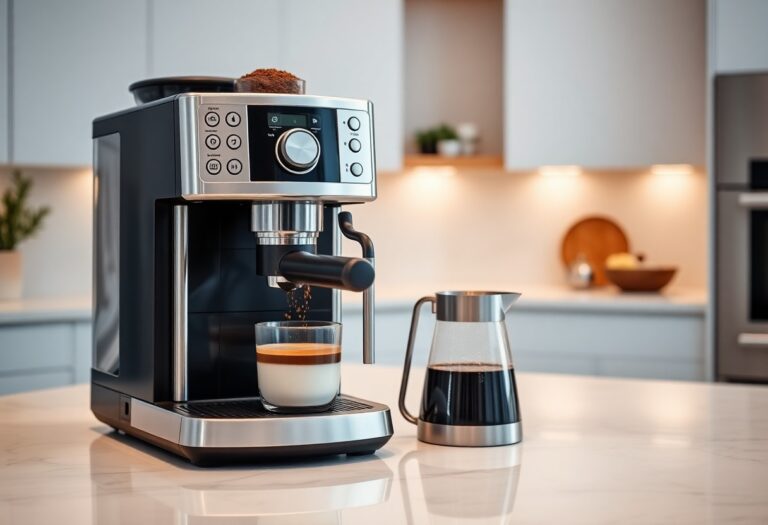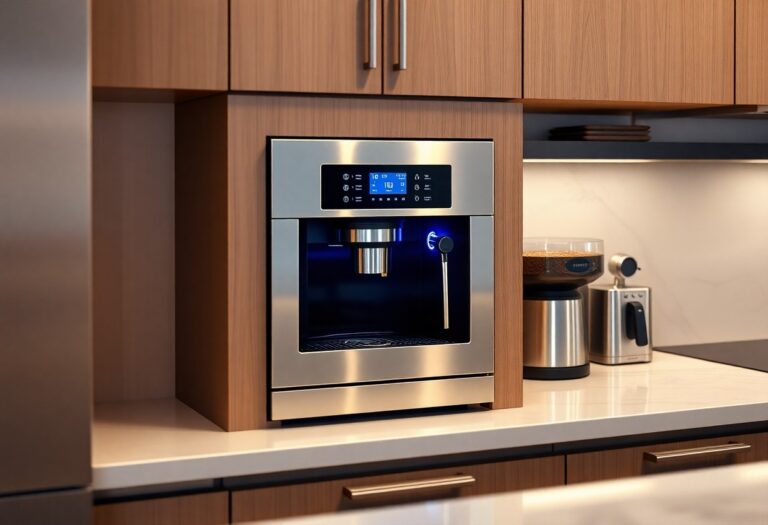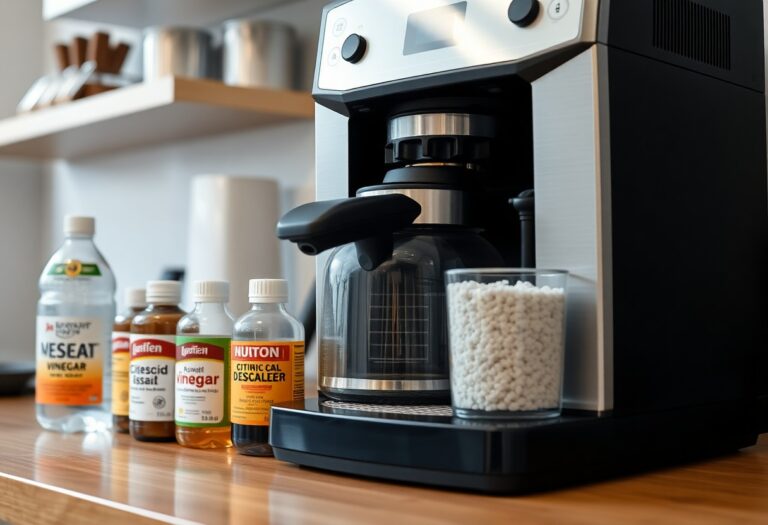What Coffee Do I Use in an Espresso Machine – Personal Selection
Most coffee enthusiasts face the challenge of selecting the right beans for their espresso machines, impacting the overall flavor and quality of your brew. To achieve a rich, full-bodied espresso, you should opt for dark roasts that complement the machine’s brewing process. Additionally, consider your taste preferences and the grind size, as these factors can significantly affect the extraction and taste. By understanding these elements, you can elevate your espresso experience and enjoy a beverage that perfectly suits your palate.
Key Takeaways:
- Choose high-quality beans that are specifically roasted for espresso to ensure a rich flavor and proper extraction.
- Opt for a medium to dark roast profile, as these provide deeper flavors and a pleasant crema.
- Consider single-origin beans for unique flavor notes or blends for a balanced taste experience.
- Freshly ground coffee beans are crucial for optimal flavor; grind the beans just before brewing.
- Experiment with different bean flavors and origins to find your personal preference and perfect cup of espresso.

The Flavor Profile: What Makes Espresso Unique?
Espresso is celebrated for its rich, concentrated flavors that exemplify the essence of coffee. The brewing method highlights various taste elements, including sweetness, acidity, and bitterness, resulting in a complex flavor profile. The unique extraction process—forcing hot water through finely-ground coffee—often brings out a more pronounced taste than traditional brewing methods, emphasizing those characteristics that define your espresso. This intensity attracts enthusiasts seeking to explore and appreciate diverse flavor notes that can range from fruity and floral to chocolaty and nutty.
The Role of Beans in Flavor Complexity
The choice of beans significantly impacts the overall flavor complexity of your espresso. Arabica beans, known for their sweetness and nuanced flavors, contrast with Robusta beans, which bring a bold, earthy element. Each origin, from Ethiopian to Colombian, contributes distinct flavor notes inherent to the beans’ growing conditions and processing methods. Selecting the right blend can radically transform your espresso experience, allowing you to savor the variety that coffee has to offer.
How Roast Levels Influence Taste
Roast levels are pivotal in shaping the flavor spectrum of your espresso. Light roasts typically yield brighter, more vibrant acidity and pronounced fruit notes, while dark roasts offer deeper, bolder flavors with rich chocolate and caramel undertones. Depending on your preference, you might find yourself drawn to medium roasts that strike a balance between the two, providing a harmonious blend of acidity and sweetness.
A light roast emphasizes acidity and intricate flavors; a taste profile that often appeals to coffee purists looking to highlight the beans’ inherent qualities. In contrast, a dark roast delivers intense flavors, often masking the subtleties of the bean origins. Medium roasts, often the most versatile, present a well-rounded experience, bringing together the best of both worlds. Experimenting with different roast levels not only enhances your espresso but also helps you identify personal preferences, as each roast unveils a new layer of the coffee’s complex personality.

Bean Selection: Delving into Single Origin vs. Blends
Choosing between single origin and blends can significantly influence your espresso flavor profile. Single origin coffees come from one specific region or farm, offering unique flavors influenced by local soil and climate conditions. Blends, on the other hand, combine beans from various origins to create a more balanced taste. Depending on your brewing preferences and taste preferences, either option might be suitable for your espresso machine.
Characteristics of Single Origin Beans
Single origin beans boast distinctive flavors that highlight the unique characteristics of their specific growing region. For instance, Ethiopian beans often feature floral and fruity notes, while Colombian varieties might be more balanced with rich caramel undertones. This clarity of flavor makes single origin options particularly appealing for those who appreciate a well-defined profile in their espresso.
The Benefits and Drawbacks of Blends
Blends offer a unique combination of beans, which can lead to a harmonious flavor profile that balances the strengths and mitigates weaknesses of individual beans. With blends, you’ll often experience a consistency in flavor, allowing for predictable results across different batches. However, some may argue that blends sacrifice the unique taste characteristics of single origin beans, resulting in a more generic experience. Depending on your taste, this can be both an advantage and a drawback.
The versatility of blends makes them a popular choice for espresso enthusiasts who enjoy a balanced cup. By combining multiple beans, you ensure a layered flavor profile with complexity that can highlight various tasting notes. For example, blending a chocolatey Brazilian bean with a bright Kenyan can lead to an espresso that is both smooth and vibrant. While blends can sometimes lack the clarity found in single origin coffees, they often offer you a consistent and enjoyable experience that invites exploration of different flavor combinations.
Grind Size and Consistency: Key Elements of Espresso Preparation
Espresso relies heavily on both grind size and consistency to extract the desired flavors correctly. The ideal grind size for espresso is fine, akin to table salt, allowing water to flow through the coffee grounds quickly while ensuring maximum flavor extraction. Variations in grind size can dramatically alter the taste and body of your espresso, leading to a bitter or sour outcome depending on whether the grind is too fine or too coarse.
The Science Behind Ideal Grind Size
The extraction process occurs through a balance of water flow and grind size. Fine grinds expose a greater surface area, which facilitates quicker extraction of flavors and oils. Too fine a grind, however, can lead to over-extraction and bitterness, while a coarse grind may result in under-extraction, producing a sour flavor. The timing of extraction is finely tuned by adjusting the grind size, where ideal extraction typically occurs between 25 to 30 seconds for a double shot.
Equipment Recommendations for Optimal Consistency
Investing in a high-quality burr grinder is vital for achieving a consistent grind size. Burr grinders provide a uniform particle size, ensuring even extraction across all coffee grounds. Brands like Breville and
When selecting a burr grinder, consider options with variable grind settings that let you fine-tune to your espresso machine’s specifications. A grinder with a digital timer can help you achieve exact dosage, minimizing wastage and maximizing your beans’ potential. Models like the Baratza Sette 270Wi not only grind with precision but also feature weight-based dosing, ensuring you get the right amount of coffee every time, enhancing your espresso preparation experience.
Understanding Freshness: The Importance of Using Fresh Beans
Freshness plays a vital role in your espresso’s flavor profile. The best coffee is made with beans that were roasted no more than a few weeks prior. As time passes, the oils in the beans oxidize, leading to dull flavors and reduced aromas. Seeking coffee that’s been roasted recently will greatly enhance your espresso experience. For insights on choosing quality coffee, check out this guide on how to choose coffee beans for your home espresso.
How to Determine the Freshness of Coffee Beans
To gauge freshness, pay attention to the roast date printed on the packaging. Ideally, choose beans roasted within the last two weeks. Additionally, take note of the smell; fresh coffee has a vibrant, fragrant aroma, while stale beans often have a flat scent. If they’re packaged in a vacuum-sealed bag with one-way valves, that’s a good sign of preservation.
Techniques to Preserve Bean Freshness Post-Purchase
Once you’ve acquired your fresh beans, properly storing them is imperative to maintain their quality. Keep the beans in an airtight container away from light, heat, and moisture. A cool, dark cupboard is an ideal location. Avoid storing them in the fridge or freezer, as moisture can enter the container each time it’s opened, negating the freshness.
For optimal freshness, consider using a dedicated coffee container made from materials that protect against light exposure, like ceramic or opaque glass. Additionally, only grind the amount of beans you need for each espresso session; whole beans retain their freshness longer than pre-ground coffee. By following these techniques, you’ll ensure that each cup of espresso you brew is bursting with the vibrant flavors that fresh coffee has to offer.
Customizing Your Coffee Selection: Personal Preferences Matter
Your coffee selection should reflect your unique tastes and preferences. Different beans offer a variety of flavor profiles, and as you explore, you’ll discover what resonates with your palate. From fruity and acidic to rich and chocolatey, the spectrum of coffee flavors is astounding. Don’t shy away from experimenting with various roasts or blends; creating a personal coffee experience is part of the joy of using an espresso machine.
Experimenting with Flavor Notes and Profiles
Delving into different flavor notes can transform your espresso experience. Try exploring beans with tasting notes of caramel, citrus, or nuts, and see how they influence your brew. Additionally, opt for single-origin coffees that highlight specific regions, allowing you to capture the essence of the location’s soil and climate.
Adapting Your Selection to Brewing Methods
Your choice of coffee will also be influenced by the brewing methods you employ. Different methods highlight distinct characteristics, affecting how flavors are extracted. For instance, espresso benefits from a fine grind that enhances its boldness, while a coarser grind suits a French press, promoting a mellower experience.
Adjusting your coffee selection based on brewing methods elevates your espresso game. An espresso machine typically requires a finely ground coffee to create that coveted crema and full-bodied taste, while other methods may call for a medium or coarse grind. Experiment with various beans that align with each brewing style; for example, fruity and bright coffees shine in a pour-over, while darker, richer roasts excel in espresso blends. By understanding how different brews complement your chosen beans, you can tailor your coffee enjoyment and discover the perfect balance of flavor and intensity.
Final Words
Presently, selecting the right coffee for your espresso machine can significantly enhance your brewing experience. You should opt for high-quality, freshly roasted beans specifically designed for espresso, as they will provide the rich flavor and crema you desire. To learn more about the best type of ground coffee for your espresso machine, feel free to check out this What Type of Ground Coffee for Espresso Machine resource. Experimenting with different blends can lead you to your perfect cup, tailored to your specific taste preferences.
FAQ
Q: What type of coffee beans should I use for my espresso machine?
A: For espresso machines, it’s best to use coffee beans that are specifically roasted for espresso. These are typically darker roasts, like Espresso Roast or Italian Roast, which bring out bold flavors. Look for beans labeled as “espresso” or “espresso blend” from reputable coffee brands for optimal results. Additionally, consider single-origin varieties if you want to explore unique flavor profiles.
Q: Should I use ground coffee or whole beans in my espresso machine?
A: Whole beans are recommended for use in espresso machines. Grinding your beans just before brewing ensures maximum freshness and flavor. An espresso grind is crucial, which is much finer than what you’d typically use for drip coffee. If you don’t have a grinder, be sure to purchase pre-ground coffee that is labeled specifically for espresso.
Q: How fresh should my coffee beans be for espresso?
A: For the best taste, use coffee beans that are freshly roasted. Ideally, coffee should be consumed within 2 to 4 weeks of its roast date. After this period, flavors can begin to degrade due to oxidation. Store your coffee beans in an airtight container in a cool, dark place to preserve their freshness and flavors for as long as possible.
Q: Can I use flavored coffee in my espresso machine?
A: While you can technically use flavored coffee in your espresso machine, it may not yield the best results in terms of taste and quality. Flavored coffees often have added oils that can clog the machine or affect the extraction process. If you enjoy flavored coffee, consider adding flavored syrups to your espresso after brewing for better control over flavor infusion.
Q: How does the grind size affect my espresso?
A: The grind size plays a significant role in espresso preparation. A fine grind is necessary to create the right amount of resistance for the water as it passes through the coffee, which aids in extracting flavor and creating a rich crema. If your grind is too coarse, the espresso may taste weak and watery; if it’s too fine, it may lead to over-extraction and bitterness. Experimenting with grind size can help you achieve your desired flavor profile.







